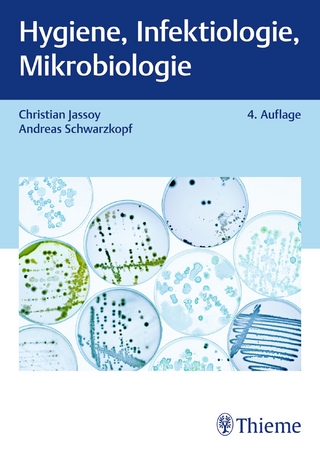
Lab Manual and Workbook in Microbiology: Applications to Patient Care
McGraw-Hill Professional (Verlag)
978-0-07-340239-0 (ISBN)
- Titel ist leider vergriffen;
keine Neuauflage - Artikel merken
The emphasis of this lab manual is on the basic principles of diagnostic microbiology for students preparing to enter an allied health field. Students are led through a series of exercises that allow them to learn basic microbiology techniques and to practice safety in the laboratory and hospital environment. It remains oriented primarily toward meeting the interests and needs of those who will be directly involved in patient care and who wish to learn how microbiological principles should be applied in the practice of their professions.
The authors have emphasized the purposes and function of the clinical microbiology laboratory in the diagnosis of infectious diseases. The exercises illustrate as simply as possible the nature of laboratory procedures used for isolation and identification of infectious agents as well as the principles of asepsis, disinfection and sterilization. Attention is given to the role of the health professional in regard to appropriate collection of clinical specimens and the applications of aseptic and disinfectant techniques as they relate to patient care.
1. The Microscope 2. Handling and Examining Cultures 3. Simple Stains, Hanging Drop, and Wet-Mount Preparations
Experiment 3.1 Preparing a Simple StainExperiment 3.2 Preparing a Hanging Drop
Experiment 3.3 Preparing a Wet Mount
4. Gram Stain 5. Acid-Fast Stain 6. Special Stains
Experiment 6.1 Staining Bacterial Endospores (Schaeffer-Fulton Method) Experiment 6.2 Flagella and Capsule Stains
7. Culture Media 8. Streaking Technique to Obtain Pure Cultures 9. Pour Plate and Subculture Techniques
Experiment 9.1 Pour-Plate Technique
Experiment 9.2 Subculture Technique (Picking Isolated Colonies for Pure Cultures)PART TWO Destruction of Microorganisms Physical Antimicrobial Agents Chemical Antimicrobial Agents Exercises10. Moist and Dry Heat
Experiment 10.1 Moist Heat
Experiment 10.2 Dry Heat
Experiment 10.3 Incineration 11. The Autoclave 12. Disinfectants Case Study: A Lesson Learned—Follow Proper Procedures for the Disinfection of Equipment 13. Antimicrobial Agent Susceptibility Testing and Resistance
Experiment 13.1 Disk Agar Diffusion Method
Experiment 13.2 Broth Dilution Method: Determining Minimum Inhibitory Concentration (MIC)
Experiment 13.3 Bacterial Resistance to Antimicrobial Agents PART THREE Diagnostic Microbiology in Action General Considerations Microbiology at the Bedside Collection and Transport of Clinical Specimens for Culture Precautions for Handling Specimens and Cultures Normal Flora of the Body Principles of Diagnostic Microbiology Exercises14. Primary Media for Isolation of Microorganisms 15. Some Metabolic Activities of Bacteria
Experiment 15.1 Simple Carbohydrate Fermentations
Experiment 15.2 Starch Hydrolysis
Experiment 15.3 The Indole Test
Experiment 15.4 Use of Kligler Iron Agar 16. Activities of Bacterial Enzymes
Experiment 16.1 The Activity of Urease
Experiment 16.2 The Activity of Catalase
Experiment 16.3 The Activity of Oxidase
Experiment 16.4 The Activity of Deoxyribonuclease (DNase)
Experiment 16.5 The Activity of a Deaminase 17. Principles of Antigen Detection and Nucleic Acid Assays for Detection and Identification of Microorganisms 18. Staphylococci
Experiment 18.1 Isolation and Identification of Staphylococci
Experiment 18.2 Staphylococci in the Normal Flora Case Study: Community-Acquired Methicillin-Resistant Staphylococcus 19. Streptococci, Pneumococci, and Enterococci
Experiment 19.1 Identification of Group A Streptococci (Streptococcus pyogenes) Case Study: A Case of Pharyngitis
Experiment 19.2 The CAMP Test for Group B Streptococci (Streptococcus agalactiae)
Experiment 19.3 Identification of Pneumococci (Streptococcus pneumoniae) Case Study: A Case of Pneumonia with Meningitis
Experiment 19.4 Identification of Enterococci
Experiment 19.5 Streptococci in the Normal Flora 20. Haemophilus, Corynebacteria, and Bordetella
Experiment 20.1 Haemophilus
Experiment 20.2 Corynebacteria
Experiment 20.3 Bordetella Case Study: A School-Associated Pertussis Outbreak 21. Clinical Specimens from the Respiratory Tract
Experiment 21.1 Laboratory Diagnosis of a Sore Throat
Experiment 21.2 Laboratory Diagnosis of Bacterial Pneumonia Experiment 21.3 Antimicrobial Susceptibility Test of an Isolate from a Clinical Specimen
22. The Enterobacteriaceae (Enteric Bacilli) and Other Clinically Important Gram-Negative Bacilli
Experiment 22.1 Identification of Pure Cultures of Enterobacteriaceae from the Normal Intestinal Flora
Experiment 22.2 Isolation Techniques for Enteric Pathogens Case Study: A Case of Diarrhea
Experiment 22.3 Identification Techniques for Enteric Pathogens
Experiment 22.4 Serological Identification of Enteric Organisms
Experiment 22.5 Techniques to Distinguish Nonfermentative Gram-Negative Bacilli from Enterobacteriaceae
Experiment 22.6 Rapid Methods for Bacterial Identification 23. Clinical Specimens from the Intestinal Tract
Experiment 23.1 Culturing a Fecal Sample
Experiment 23.2 Identification of an Unknown Enteric Organism
Experiment 23.3 Antimicrobial Susceptibility Test of an Enteric Organism 24. Urine Culture Techniques
Experiment 24.1 Examination and Qualitative Culture of Voided Urine
Experiment 24.2 Quantitative Urine Culture Case Study: A Case of Cystitis 25. Neisseria and Spirochetes
Experiment 25.1 Neisseria
Experiment 25.2 Spirochetes Case Study: A Case of a Patient with a Bull’s-Eye Skin Lesion 26. Clinical Specimens from Blood Case Study: Three Patients with Positive Blood Cultures PART FOUR Microbial Pathogens Requiring Special Laboratory Techniques; Serodiagnosis of Infectious Disease; Principles and Practices of Infection Prevention Exercises27. Anaerobic Bacteria Case Study: A Case of Diarrhea in a Hospitalized Patient28. Mycobacteria
Experiment 28.1 Microscopic Morphology of Mycobacterium tuberculosis
Experiment 28.2 Culturing a Sputum Specimen for Mycobacteria 254Case Study: A Case of Pneumonia in a Patient with Chronic Alcoholism 29. Mycoplasmas, Rickettsiae, Chlamydiae, Viruses, and Prions 30. Fungi:Yeasts and Molds 31. Protozoa and Animal Parasites 32. Serodiagnosis of Infectious Disease 33. Principles and Practices of Infection Prevention
Experiment 33.1 Nasal Surveillance Cultures for MRSA
| Erscheint lt. Verlag | 16.11.2013 |
|---|---|
| Zusatzinfo | 62 Illustrations, unspecified |
| Sprache | englisch |
| Maße | 231 x 277 mm |
| Gewicht | 737 g |
| Themenwelt | Medizin / Pharmazie ► Medizinische Fachgebiete ► Mikrobiologie / Infektologie / Reisemedizin |
| Naturwissenschaften ► Biologie ► Mikrobiologie / Immunologie | |
| ISBN-10 | 0-07-340239-7 / 0073402397 |
| ISBN-13 | 978-0-07-340239-0 / 9780073402390 |
| Zustand | Neuware |
| Haben Sie eine Frage zum Produkt? |
aus dem Bereich


